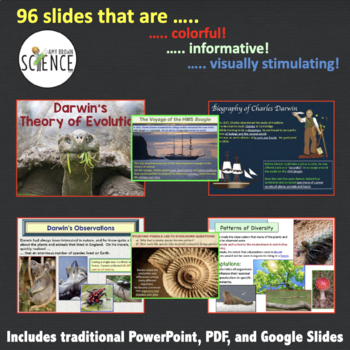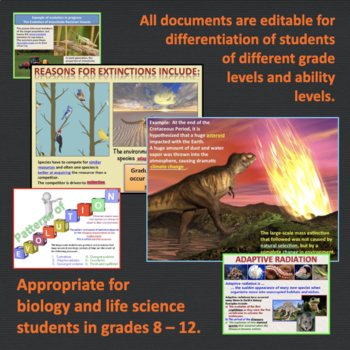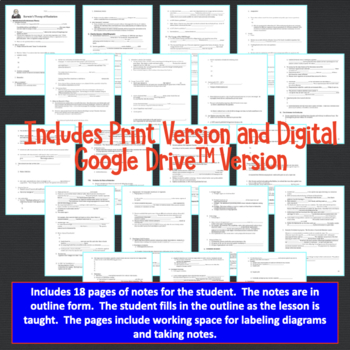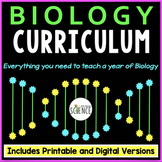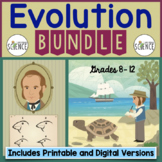Evolution and Natural Selection PowerPoint and Notes Mechanisms of Evolution
- Zip
- Google Apps™

What educators are saying
Also included in
- This NO PREP, PRINTABLE, EDITABLE, AND DIGITAL Biology Curriculum contains everything you need for an entire year of Biology! For less than $3 a day, you can save your time, energy, and sanity. Each of the 20 Complete Units includes a teaching PowerPoint presentation, notes, labs, homework assignmenPrice $525.00Original Price $988.18Save $463.18
- This Theory of Evolution Complete Unit Bundle covers the work of Darwin, natural selection, the mechanisms of evolution, homology and homologous structures, embryology, patterns of evolution, and more. See complete list of topics below.This unit bundle includes everything you need to teach an introdPrice $31.95Original Price $40.73Save $8.78
Description
In these 96 PowerPoint and Google slides, students will explore the life of Charles Darwin, natural selection, the mechanisms of evolution, the evidence for evolution, homology and homologous structures, embryology, patterns of evolution, and more. See complete list of topics below. These 96 slides will captivate your students with stunning photos and diagrams to provide an in-depth study of evolution.
Choose to use the traditional printable version, or the paperless, digital Google Apps version. These lessons on evolution detail the culture and beliefs of the 1800's and the historic travels of Darwin that led him to develop his theory of evolution. The PowerPoint covers all the topics you would expect from a traditional high school biology textbook, including natural selection, descent with modification, the fossil record, homologous structures, embryology, mass extinctions, adaptive radiations, and the many other patterns of evolution.
This resource is perfect for traditional classroom settings, distance learning, flipped classrooms, or for students in 1:1 classrooms.
Click this link to view all of my Digital Resources.
What is included in this product?
- A 96-Slide PowerPoint Presentation (Includes traditional PowerPoint, PDF, and Google slides)
- Editable and printable 14-page set of lecture notes for the teacher
- Editable and printable 18-page guided notes outline for the student
- Paperless Digital Version (not editable) for use in Google Drive, Google Classroom, and /or Microsoft OneDrive
The Power Point is designed to hold the attention of your students. The 96 slides are bright and colorful and contain loads and loads of visually appealing pictures and images. Animations and transitions are included to allow you to control the pace of the lesson.
Your students are going to love using the outline as you teach. It allows the student more freedom to listen, think, and ask questions during note-taking. The notes are also perfect for students with disabilities or IEP's.
Topics covered are:
I. Introduction to Evolutionary Theory
- Biological Diversity
- What is a Theory?
- What is Evolution?
- Who “Discovered” Evolution?
II. Charles Darwin: A Brief Biography
III. The Voyage of the HMS Beagle
IV. Darwin’s Observations
- Enormous Number of Species
- Patterns of Diversity
- Fossils
- The Galapagos Islands
- The Journey Home
V. Ideas in Darwin’s Time
- A Time of Discovery
- Conflicting Views of Darwin’s Work
- An Ancient and Changing Earth
- Georges Cuvier
- James Hutton
- Charles Lyell
- Jean-Baptiste Lamarck
- Thomas Malthus
VI. Darwin Develops His Theory of Evolution
- When Darwin Returned Home
- What Changed?
VII. Darwin’s Theory of Evolution
- Common Ancestry
- Darwin Presents His Evidence
- Descent With Modification
- Artificial Selection
VIII. Evolution by Natural Selection
- Concepts of Darwin’s theory
- What is Natural Selection?
- Common Descent
- The Controversy
- Summary and Important Points
IX. The Evidence for Evolution
- The Fossil Record
- Geographic Distribution
- Homology
- Embryology
- Biological Molecules
X. Evolution in Action
- Selection Pressure
- The Peppered Moth
- Pesticide Resistance in Insects
XI. Patterns of Evolution
- Selection Pressure
- Extinctions
- Adaptive Radiation
- Convergent Evolution
- Divergent Evolution
- Coevolution
- Punctuated Equilibrium
This PowerPoint is appropriate for any biology student in grades 9 - 12. It can be used in first or second year biology classes.
Related Products Include:
Theory of Evolution Task Cards
Theory of Evolution Homework and Study Guide
Darwin's Diary: The Tale of Evolution
Evolution and Classification Warm Ups and Interactive Notebook Pages
Evolution Lab: Modeling Natural Selection
Evolution Quizzes: Set of 2 Quizzes
A Hardy Weinberg Lab Simulation Activity
Lab: Making Coacervates Origin of Life Evolution Lab Activity
The History of Life on Earth PowerPoint and Notes
Origin of Life of Earth Homework Assignments
For updates about sales and new products, please follow my store:


